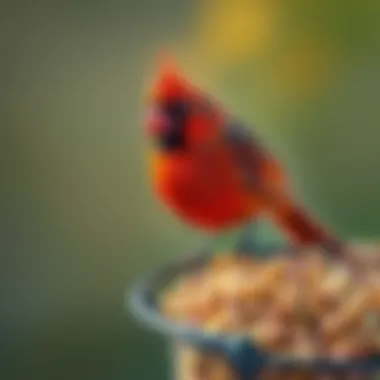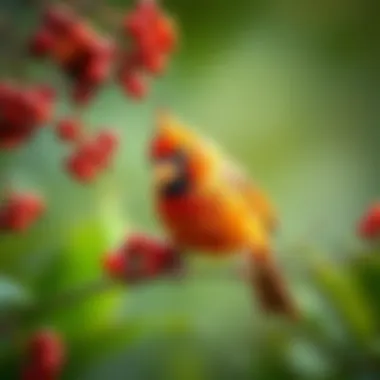Nourishing Cardinals: Best Foods to Attract Them


Intro
Cardinals are not just a feast for the eyes with their vibrant red plumage; they also bring life to gardens and backyards. Understanding the dietary wants of these birds forms the cornerstone of attracting them effectively. As such, we delve into the delicate balance of nutrition that cardinals need. Knowing the right foods to offer can transform your outdoor space into a sanctuary for these beautiful creatures.
Whether you are a seasoned birdwatcher or a novice bird guardian, creating a haven for cardinals requires more than just scattering seeds. The following sections will offer insights into their nutritional preferences, habitat setup, and overall well-being. By equipping yourself with this knowledge, you will not only enrich your environment but ensure the longevity and health of your feathered visitors. Let's take a closer look at the essentials to making your space appealing to cardinals.
Prelims to Cardinals: A Close Look
Understanding cardinals is more than a mere glance at their vivid hues; it really opens a window into their fascinating world. These birds, notably the Northern Cardinal, are familiar sights in many backyards, yet their habits and preferences are often overlooked. What drives their dietary choices? What makes their habitat so special? This article looks at cardinals from various angles, not only to appreciate their beauty but to realize the interplay between their environment and what they eat. For those eager to attract these avian wonders, knowing their needs is pivotal. Setting a stage that mirrors their natural inclination boosts not only your bird-watching experience but also supports the well-being of the cardinals themselves.
Understanding Cardinal Species
Diving into the specifics of cardinal species can be eye-opening. Among the various types, the Northern Cardinal reigns supreme in North America, known for its striking male, clad in bright red plumage, and the more subtly hued female. But they are not alone; other species such as the Pyrrhuloxia can also be found in parts of the Southwest, albeit with a none-too-glamorous reputation compared to the Northern variety. Each species comes with its own set of quirks, dietary preferences, and habits that can significantly affect how you prepare your space to welcome them.
The Cardinal's Habitat and Ranges
Cardinals thrive in a variety of environments. Typically, they favor wooded regions, gardens, and shrublands, where dense cover offers protection. They are quite adaptable and can be spotted in urban settings too, making them easy guests for those with a little patience. In northern climates, these vibrant birds might flock to feeders as winter sets in, revealing their reliance on humans for sustenance during harsher months.
Understanding their habitat helps in deciding what types of food will best attract them, ensuring that your efforts result in a joyful cardinal sighting.
When creating a cardinal-friendly landscape, consider planting native shrubs and trees, as these provide not just food but also nesting sites. The ranges of cardinals can extend broadly, and while many reside year-round across the Midwestern United States, others may migrate in response to seasonal food availability. This seasonal shift is critical to grasp, as it informs what to offer them to satisfy their ever-changing appetites.
Nutritional Requirements of Cardinals
Understanding the nutritional requirements of cardinals is paramount for ensuring their health and well-being. Both pet bird owners and enthusiasts who wish to invite these beautiful birds into their gardens must grasp the essential nutrients that cardinals need. These needs are influenced by their habitat, the season, and many other factors that can directly affect their behavior and vitality.
Cardinals can be quite discerning when it comes to food choices. They thrive on a diet rich in seeds, fruits, and some insects. That’s not just a casual nibble — their nutritional intake plays a crucial role in their feather quality, reproductive success, and overall vitality. Thus, providing the right foods can significantly enhance their presence in your yard. When cardinals are well-fed, they’re enthusiastic and vibrant, making every sighting a joy.
Essential Nutrients: What Do They Need?
Cardinals have a diverse palate but fundamentally require a solid balance of nutrients to sustain their health. Here are some pivotal components they depend on:
- Proteins: Vital for muscle development and feather production. An influx of protein sources such as insects or high-quality bird feeds can greatly aid in their overall vigor.
- Fats: Healthy fats are essential for energy. Cardinal diets that include sunflower seeds are particularly beneficial, as they provide high-fat content to fuel their day.
- Carbohydrates: These are important for the quick energy bursts cardinals need during their agile flights. Fruits like apples and berries not only offer taste but also ensure they receive necessary carbohydrates.
- Vitamins and Minerals: Micronutrients such as calcium and vitamin A play a significant role in calcium deposition for bone strength and maintaining healthy feathers.
Providing an array of these nutrients ensures cardinals are kept in tip-top shape. But how to incorporate them? One efficient strategy could be to maintain a varied feeding supply, allowing these birds to choose what they prefer based on seasonal availability.
Seasonal Dietary Changes
Just like people adapt their meals according to the seasons, cardinals also modify their dietary choices throughout the year. During the spring and summer months, cardinals may lean heavily on insects, which are abundant during these times. This protein-packed food source is crucial for raising their young. It’s fascinating to note this shift: as the temperatures rise, your backyard may become a miniature hub of activity, buzzing with cardinals darting about in search of beetles or caterpillars.
As fall approaches, cardinals tend to pivot towards seeds and berries. A range of seeds becomes available, and their preferences can shift toward safflower seeds or even nuts, which are good sources of energy as the colder months approach. This seasonal shift isn’t arbitrary; it’s closely linked to food availability and their nutritional needs at varying life stages.
Moreover, in the frigid winter months, they often depend on backyard feeders stocked with various seeds. During this period, proprietors should maintain consistent feeding to support these birds through harsh conditions. Despite the cold, cardinals can be persistent, so your commitment to their diet will undoubtedly pay off.
"Providing the right nutrition not only sustains cardinals but also enriches your experience observing their behaviors and vibrant interactions in your garden."


Favorite Foods of Cardinals
Understanding the preferred foods of cardinals is crucial for anyone looking to attract these vibrant birds into their gardens or yards. By providing the right nutritional choices, you not only encourage them to visit but also promote their health. Cardinals, with their striking plumage and melodious calls, can enhance our outdoor spaces significantly. The right foods are like a golden ticket to pulling them in and ensuring they stick around.
Seeds: A Cardinal's Go-To
Sunflower Seeds
Sunflower seeds are perhaps the most popular food choice for cardinals. The high-fat content in these seeds provides essential energy, especially during colder months when food becomes scarce. The shells of the seeds add an extra dimension, as cardinals enjoy the act of cracking them open.
Their distinct flavor appeals to a wide range of birds, but cardinals seem particularly fond of them. With a high protein and fat ratio, sunflower seeds support robust health and vitality for these birds. A practical aspect of these seeds is their availability. Many local stores stock them, making it easy for bird enthusiasts to keep their feeders full.
One consideration, however, is the mess left behind. Shells tend to scatter around feeders, which might not please all gardeners. Still, the benefit of attracting cardinals often outweighs this minor inconvenience.
Safflower Seeds
Safflower seeds could be called the quiet achievers when it comes to bird feed. This lesser-known seed has a hard shell, which may deter some birds but seems to invite cardinals. They provide a significant source of oil and protein, similar in benefits to sunflower seeds.
One unique feature of safflower seeds is their bitterness to certain species, such as squirrels. This means they might just outlast other food types in your feeder without attracting unwelcome visitors. And as an added perk, these seeds often leave less mess compared to sunflower seeds, making them a tidy option.
However, they can be less popular than sunflower seeds, meaning that cardinals may take them only when their favorite seeds are exhausted. It’s still worth having them on hand to ensure a stable food supply throughout the seasons.
Fruits that Appeal to Cardinals
Blackberries
Blackberries can be a real treat for cardinals, especially during the warmer months when these juicy fruits are in season. Their sweetness aligns perfectly with the cardinals' preference for vibrant colors and flavors. Blackberries are rich in vitamins that support overall health and provide a hydration source during hot months.
However, a drawback is their seasonal availability. Unlike seeds, which can be offered year-round, cardinals can only enjoy fresh blackberries when they are ripe. While they may not be a consistent feed, they certainly add variety when in season, captivating cardinals with their appealing taste.
Apples
Offering apples can be another magnificent way to allure cardinals. These fruits provide a crispy texture that cardinals often find irresistible. High in fiber and vitamin C, apples can be an excellent supplement to a cardinal's diet.
One unique feature is the ability to offer them sliced. This makes it easier for the birds to access the fruit. However, care should be taken to remove any seeds, which can be harmful to them. Moreover, unlike other foods, apples may not attract cardinals as readily as seeds do. They might nibble here and there but are unlikely to engage in a feeding frenzy as they would with sunflower seeds.
The Role of Insects in Their Diet
Insects are not just an occasional snack for cardinals; they are a fundamental part of their diet, especially during the breeding season. These birds tend to crave protein sources to support their young ones' growth. Foods such as caterpillars, beetles, and ants can be vital contributors to their nutrition.
Offering insects, whether through specialized feeders or simply keeping the garden inviting to them, can foster a natural diet for cardinals. The movement and color of insects can also attract these birds, as they are naturally drawn to dynamic food sources. Nonetheless, some people may feel squeamish about having insects in their garden. That said, this additional protein source plays a crucial role in sustaining the wellbeing of cardinals, especially when they are feeding their chicks.
Creating an Inviting Environment
Creating an inviting environment for cardinals is crucial for attracting these beautiful birds to your garden. When considering what will draw them in, think about mixing various elements that cater to their basic needs. An inviting environment combines food sources, shelter, and a space where these birds feel safe. By orchestrating the right conditions, you both encourage their presence and promote their health.


Best Practices for Feeding Cardinals
Feeding cardinals requires thoughtfulness; it ain’t just about tossing some seeds on the ground. To really catch their fancy, place feeders at varied heights. This prevents other larger birds from scaring them away. Additionally:
- Use feeders specifically designed for smaller birds.
- Offer a variety of seeds like sunflower and safflower to entice their taste buds.
- Keep feeders clean to avoid mold or spoiled food, a real turn-off.
As seasons change, alter the food offerings as well. For instance, in winter, nuts and seeds are a big hit; during warmer months, fruits can be more appealing.
Using Feeders Effectively
Feeders play a central role in attracting cardinals. They not only provide food but also create a place for birds to congregate. To maximize the effectiveness of your feeders:
- Location is Key: Place feeders near trees or bushes, as cardinals love to dart for cover. Just a few feet away from the windows can keep them close yet safe from predators.
- Choose the Right Feeder Style: Tube feeders are great for sunflower seeds, while platform feeders work well for fruits.
- Regular Refills: Make it a point to refill feeders regularly. Cardnials are creatures of habit, and your consistency can build trust.
Additionally, it's beneficial to monitor which types of feeders work best at different times, as their preferences can shift.
Planting Cardinal-Friendly Flora
One of the most organic ways to invite cardinals into your space is through planting. Consider nurturing plants that not only offer food but also shelter. This can enhance the attractiveness of your garden manifold. Here are some plants to consider:
- Native Berry-Bearing Shrubs: Plants such as holly and serviceberry provide not only fruit but protective cover.
- Sunflower Plants: These are like the candy shop for cardinals; they will flock to your yard if sunflowers are in bloom.
- Native Trees: Trees such as oaks and maples offer seeds and shelter that attract cardinals throughout the year.
By planting a good mix of these plants, you create a dynamic habitat that nourishes cardinals and you’ll likely find yourself enjoying their colorful presence more frequently.
"Creating an inviting environment takes patience, but the joy of witnessing cardinals up close is worth every effort."
In summary, assembling the right elements to create a haven for cardinals involves both strategic feeding practices and thoughtful landscaping choices. With a tad of effort and the right approach, you can watch these striking birds make themselves at home.
Challenges in Feeding Cardinals
Feeding cardinals might seem straightforward, but it presents a unique set of challenges. Understanding these challenges can help bird enthusiasts create the best environment for these charming creatures. Without proper consideration, feeding efforts can either go awry or lead to inefficiencies that ultimately detract from the joy of observing cardinals. This section outlines two significant challenges: managing competition among birds and addressing food spoiling issues. As we delve into this, it becomes evident that these factors are pivotal for maintaining a harmonious feeding experience.
Managing Competition Among Birds
Cardinals, with their bright plumage and hearty appetites, are popular among bird watchers. However, when their feeding area attracts not just cardinals, but other bird species, it can lead to fierce competition—some folks call it a “bird buffet brawl.” This situation often means that cardinals may feel outnumbered and consequently shy away from feeding.
To mitigate this challenge, consider these strategies:
- Selective Feeding: Using feeders designed to accommodate cardinals. Tube feeders with larger perches can help cardinals to feast without being overtaken by smaller birds like sparrows or finches.
- Feeding Schedule: Observe times of day when cardinals are most active and refill feeders during those hours. Having food available when cardinals are likely to arrive can increase their chances of escaping the flock.
- Meal Variety: Offering a mix of seeds that cardinals love, such as sunflower and safflower, can help draw them in before other species. This way, cardinals can enjoy their meals without feeling rushed.
“Birds compete for resources just like people do. Understanding their behaviors can lead to a better feeding environment.”
Creating a dedicated feeding zone, away from frequent bird traffic, can also work wonders. It allows cardinals a sense of safety that prompts them to revisit routinely.
Addressing Food Spoiling Issues


Food spoilage can be a sneaky adversary when you're trying to feed cardinals, especially in warmer months. Spoiled food can not only deter cardinals but can also pose health risks to them. Hence, being proactive in ensuring your feeding setup remains tidy is paramount. Here are steps to take for keeping food fresh:
- Regular Cleaning: Maintain your feeders and stations by cleaning them weekly. A simple mix of warm water and a little vinegar can do the trick. This process removes leftover seeds that could mold and harbor harmful bacteria.
- Quality Over Quantity: Invest in high-quality bird food. Often, cheaper seed blends include fillers that can spoil quickly. Look for options that prioritize nutrient-rich ingredients without skimping on freshness.
- Weather Considerations: During rainy or humid spells, it's wise to check and replace food more frequently. Extremes in weather can accelerate spoilage, so adjust your feeding routine according to conditions.
When done right, addressing competition among birds and keeping a close eye on food quality not only attracts cardinals, but enhances your entire avian experience. Understanding these challenges equips bird enthusiasts with the knowledge necessary to maintain a bustling, vibrant feeding station. As you overcome these hurdles, you’ll find the joy of observing cardinals will be ever so rewarding.
Monitoring Cardinal Health and Behavior
To nurture cardinals effectively, understanding their health and behavior becomes paramount. Observing these elements helps create a compelling environment where these birds can thrive. Spotting subtle cues in their health, such as feathery luster or energetic antics, may signal their overall wellbeing. In short, engaged bird parents can offer care that aligns with these observations, ensuring a nuanced understanding of their pet's needs. Proper monitoring of cardinals fosters strong bonds and responds to their changing dietary habits, which can be especially crucial with seasonal shifts.
Identifying Signs of Wellbeing
Establishing a baseline for what constitutes a healthy cardinal is necessary. Here are some indicators that all is well:
- Feather Quality: Bright and smooth feathers typically reflect good health. Look for colors—not just the red of males or the brown hues of females—but overall radiance. Dull feathers or missing patches suggest issues that could need attention.
- Activity Level: Cardinals are generally active birds. Robust movement and curious exploration of their feeder or plants indicate health. If they seem subdued or spend excess time perched in one place, it could hint at underlying issues.
- Vocalizations: Listen closely. Cardinals often sing a variety of notes. A lack of chirping or unusual silence may suggest something is amiss.
- Eating Habits: Watch how they eat. Are they munching happily? Changes in appetite or wild pecking are clear signs to monitor.
Understanding Feeding Interactions
Acknowledging how cardinals interact with their food and feeding environment sheds light on their overall health. Their feeding behavior can change based on several factors:
- Social Dynamics: Cardinals exhibit a social structure. Often, they eat in pairs or small groups. Identifying social interactions can provide insights—if a cardinal is kept away from others at the feeder, it might indicate some competetive issues.
- Adaptations to Food Source: Seasonal variations bring changes in food availability, which can make feeding behaviors vary. For instance, if a cardinal is notably less active during winter months, struggling to find food, then sourcing high-energy foods is key to support its needs.
- Health and Food Recognition: A healthy cardinal will prioritize certain foods. If they consistently avoid a specific item, it’s essential to reassess its nutritional integrity or consider alternative offerings.
Understanding these feeding interactions adds layers to how pet bird owners can respond appropriately. Keeping their paws on the pulse of what's happening behaviorally offers clues to nutritional correctness.
"Birds are keys to the sky, and a cardinal's wellbeing unlocks a connection between nature and nurture."
By mastering these aspects of monitoring, bird enthusiasts not only foster healthier habits but ensure that their feathered companions enjoy a pleasant life, contributing to their longevity.
Finale: Enhancing Your Cardinal Experience
As we wrap up our exploration of attracting cardinals, it’s vital to reflect on the pivotal role that proper nutrition plays in the lives of these stunning birds. Understanding their dietary needs not only maximizes the chances of cardinals visiting your garden but also contributes to their overall health and well-being. Providing the right food offerings allows these creatures to thrive, making each sighting a joy for bird watchers and enthusiasts.
By ensuring that cardinals have a balanced diet, you enable them to exhibit their natural behaviors, establish nests, and raise young. This creates a vibrant ecosystem in your backyard, where each season brings a new set of interactions. It’s more than just feeding; it’s about fostering a thriving community.
"Every cardinal that flits into your garden is a testament to your efforts in creating an inviting atmosphere. The beauty of these birds, with their striking colors, brings life and delight to any space."
Reflecting on Cardinal Nutrition
When considering the nutritional choices discussed earlier, it’s essential to deeply understand what motivates cardinals’ feeding habits. Cardinals are not just after any seeds; they show a marked preference for those high in fat and protein, like sunflower seeds. Ensuring that your food offerings align with these preferences makes a world of difference.
In addition, seasonal awareness plays a significant role in attracting these birds. As natural food sources fluctuate throughout the year, so does the cardinal’s dietary needs. Understanding this rhythm can help bird enthusiasts adapt their feeding strategies and offer novel food sources, which encourages cardinals to visit more regularly.
Future Considerations for Bird Enthusiasts
For those deeply invested in the world of birdwatching, staying informed about environmental changes and their impacts on local wildlife is crucial. With habitat loss and climate change affecting food sources, bird lovers must engage in sustainable practices to support not only cardinals but all bird populations.
Future steps could include:
- Planting native species: Native plants are key food sources and provide the right habitats for cardinals and other birds.
- Advocacy for conservation: Get involved with local conservation efforts to protect natural habitats.
- Continuous learning: Educate yourself about local bird species and their specific needs.
- Community involvement: Share knowledge and resources within your neighborhood to create a collective effort in bird conservation.
Remember, creating an enriching environment for cardinals not only enhances your experience but also contributes significantly to their survival in the changing world. The more you learn and adapt, the better your results will be in attracting these beautiful birds into your life.















